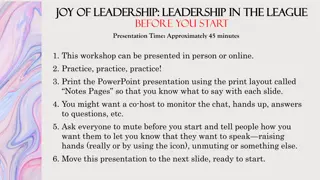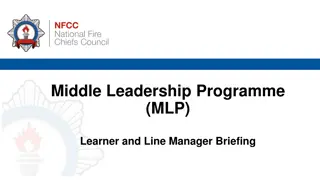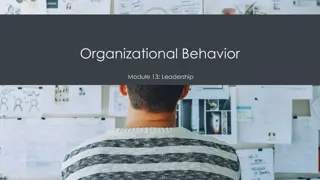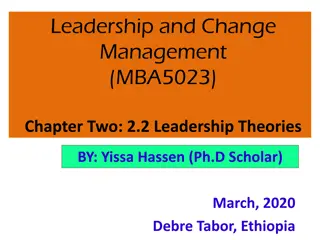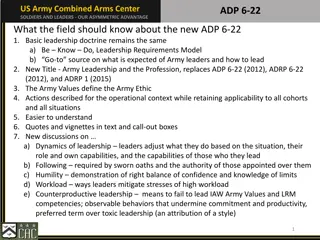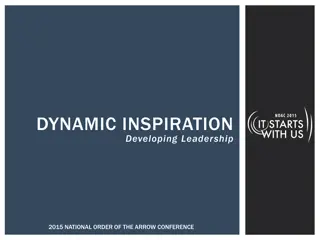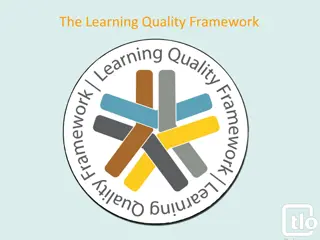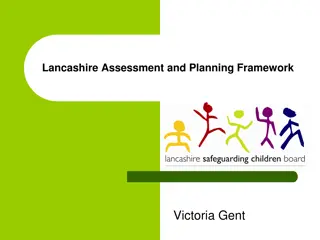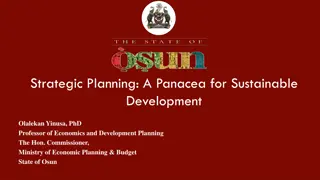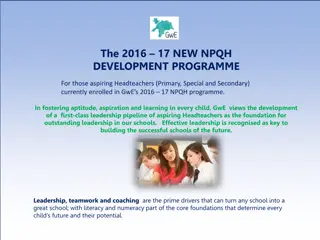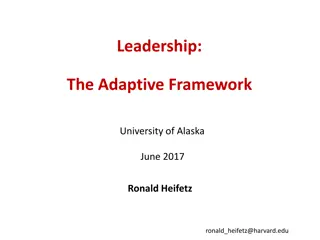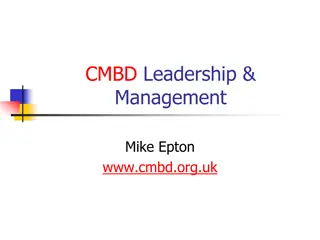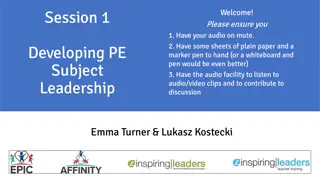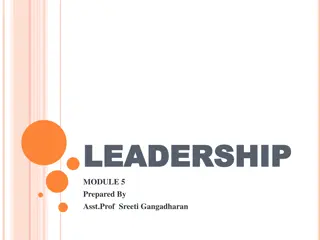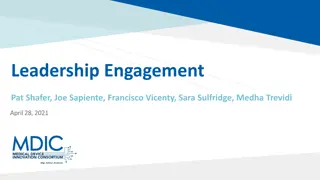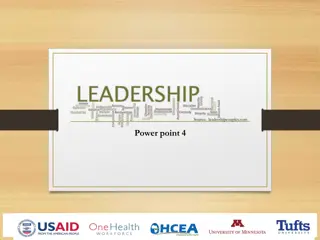Essential Leadership in Planning Quality Framework
This content delves into the importance of quality frameworks in planning, emphasizing leadership essentials and the need for change. It explores questions on value delivery, resource allocation, and challenges to the status quo in a dynamic world. The emphasis is on creating a change agenda through proactive leadership rather than reactive planning.
Download Presentation

Please find below an Image/Link to download the presentation.
The content on the website is provided AS IS for your information and personal use only. It may not be sold, licensed, or shared on other websites without obtaining consent from the author.If you encounter any issues during the download, it is possible that the publisher has removed the file from their server.
You are allowed to download the files provided on this website for personal or commercial use, subject to the condition that they are used lawfully. All files are the property of their respective owners.
The content on the website is provided AS IS for your information and personal use only. It may not be sold, licensed, or shared on other websites without obtaining consent from the author.
E N D
Presentation Transcript
The Planning Quality Framework Leadership essentials Oct 2014 Steve Barker PAS www.qualityframework.net www.pas.gov.uk
Today Planning Quality Framework Me Why do we need it? What is it? How does it work? What does it do? You Is it useful? 2 exercises to help us develop it Q&A as we go
top quartile performer (this is not uncommon)
or is quality Leading to: Time for a change?
why we need a quality framework the focus will always be on speed until there is something better to care about how much of what? measures not targets did that work? routine / unusual focused improvement did we/do we add value? good ideas wasted time/effort big stuff / small stuff evidence / guesses VFM validation permitted development end-to-end conditions do customers like us? neighbours feel ignored?
leadership does not manage the status quo; it challenges it planning - passive, reactive to change? time to create the change agenda? designation = how can we get quicker? better questions: how do we measure and deliver value and quality? and how do we resource in an unpredictable world ?
councillors: better value from data Previous PAS work officer focused Councillors: not just about access to data elected members need access to performance data they can use
demonstrate the value of your work There s nothing new under the sun Ecclesiates 1;9 performance management customer care, customer satisfaction pre-app and post app reviews annual monitoring reports, design guides
demonstrate the value of your work There s nothing new under the sun Ecclesiates 1;9 performance management reporting system data (e.g. PS1/2 returns) customer care, customer satisfaction pre-app and post app reviews, AMR that you can report and compare. PQF: re-frames and enhances what you already do and applies some standards so
what is the planning quality framework?
in a nutshell A collection of tools and techniques that use data to make reports that help councils understand DM service performance and/or benchmark against others.
no single measure of quality Agents Agents Applicants Applicants The work The work Quantitative Qualitative Outcomes Outcomes Value Value Resources Resources Neighbours Neighbours Process Process Reviewer(s) Reviewer(s) What if ? What if ? Organisational Organisational - - (ICT, teams, headcounts etc.) teams, headcounts etc.) (ICT, Amenit Amenit y y Groups Groups C llrs C llrs Staff Staff outcomes outcomes Practice ? ? build build Design Design Q&A Q&A Tips Tips
Overview Outcome Outcome s s Agents Agents Applicants Applicants Qualitative The work The work Quantitative Resource Resource s s Value Value Neighbours Neighbours Process Process Reviewer(s) Reviewer(s) Opinions What if ? What if ? Facts Organisational Organisational - - (ICT, teams, headcounts etc.) teams, headcounts etc.) (ICT, Amenit Amenit y y Groups Groups C llrs C llrs Staff Staff Design, build, Design, build, outcomes outcomes Practice helpful tools ? ? Q&A Q&A Tips Tips
quantitative: applications data The work The work Outcomes Outcomes Value Value Resources Resources Process Process What if ? What if ?
qualitative: 8 customer Surveys Agents Agents Applicants Applicants Neighbours Neighbours Officer Officer Organisational Organisational - - (ICT, teams, headcounts etc.) teams, headcounts etc.) (ICT, Amenity Amenity Groups Groups C llrs C llrs Staff Staff
practice NPPF integrated into policy Appeals / refusals based on design Focus on design at PreApp Design guides / panels BREEAM Building for Life In house design expertise Councillor reviews of development negotiation negotiation outcomes outcomes Design Design Pre/post app Pre/post app
Its a framework Agents Agents Applicants Applicants The work The work Quality Outcomes Outcomes Value Value Resources Resources Neighbours Neighbours Process Process Reviewer(s) Reviewer(s) What if ? What if ? How are you organised ? How are you organised ? (ICT, teams, headcounts (ICT, teams, headcounts etc.) etc.) Amenit Amenit y y Groups Groups C llrs C llrs Staff Staff negotiation negotiation outcomes outcomes Design Design Pre/post app Pre/post app
1. Quantitative Quarterly reports: the rounded picture: Q: how many expensive process reviews focus on speeding things up but fail to notice that the service says yes more oftenthan its peers, creates less waste and has happier customers?
less of this ?????! 35 pages of histograms
more of this Online Structured story Part 1 The work Part 2 The outcomes Part 3 Value/non-value Part 4 Resources Part 5 - Process Part 6 - Surveys Council Planning Quality Report Trends over time Database DIY reports
PART 1 - THE WORK 1a. development categories Big stuff
PART 1 - THE WORK 1b. Application Counts/ Fee Comparator Purpose: To understand your work and fee income and compare with your peers.. work profile fee profile For review: Are you very different from your peers? Are peers seeing more of a particular type of development? Something to learn? Do the applications / fees mix represent any risk? Are you managing this risk appropriately ?
PART 2 - OUTCOMES 2a. Approval Rates Purpose: What types of development are we saying 'yes' to and how often? For review: Granting more permissions? Messages for stakeholders? Is the %age of permissions always a positive? Do your approval rates differ significantly from your peers? What might be happening elsewhere that you can learn from?
PART 3 VALUE/NON VALUE 3a. Withdrawn applications Purpose: Rate of withdrawal. A 'waste' indicator. Where possible they should be reduced to near zero. For review: What is the overall trend ? Are you doing anything - is it working? What s the cost? Fees don t cover costs. Then the 'free go ? How many occur at the request of the council? What do your developer community think ?
3b. Follow-up applications Purpose: Permission to start? 'follow-ups series of apps for same development. Often the market (EoTs, some NMA), sometimes required by us (vary/remove conditions). For review: These don t cover the costs Is there anything to be done? Complex Vs simple What do developers think? Is there a positive/negative story here?
PART 4 RESOURCES 4b. Headcount estimate Purpose: how well matched are resources (FTEs) to the volumes of work? For review: How does the FTE estimate compare to reality? Caseloads? Does the trend correspond with volumes? Are there opportunities to re-focus resources?
4c. Development investment Purpose: What is the investment value that development proposals represent? For review: significant inward investment sum Vs cost of planning What do the trends (rising/falling) mean for your place? Significance between this and fee income (e.g. future resources available)? FTE estimate (e.g. can you handle a growing upward trend, or re-focus resources for a downward trend)?
PART 5 PROCESS 5a. Valid on day 1 Purpose: Shows the proportion of applications received that can be worked on straight away. For review: This is avoidable time and cost Causes. Don't assume are the sole fault of the applicant/agent. Are your procedures, processes, consistency and guidance as good as it could be? What are your customers saying? Are some application more vulnerable than others?
Quick guide to box plots Why do we use boxplots? Shows variation in a set of data something an average doesn t. e.g. average decision 48 days. Hides fact that most are issued between 35 and 54 days. Knowing this you can: Average be clearer to customers Improvement opportunity improve the process what is stopping us making 35 days?
5c. end-to-end decision times Purpose: Shows the number of days between applications being received and a decision notice being issued.
WHAT IF? compare me to my peers (you d expect that) compare me to best of breed (interesting) make me look like the best (very interesting)
Exercise 1 Task: Design a dashboard of key planning measures for councillors Hints/tips: No more than 5 or 6 What do you need at your finger tips? Who s your audience(s)?
Part 2 - customer surveys Agents Agents Applicants Applicants Neighbours Neighbours Officer Officer Organisational Organisational - - (ICT, teams, headcounts etc.) teams, headcounts etc.) (ICT, Amenity Amenity Groups Groups C llrs C llrs Staff Staff
customers part 1 (regular, application - specific) applicants (members of the public that have made a planning application) agents (a professional person or company making a planning application) neighbours (a person/organisation that has commented on an application) officer case review (for the council to assess how well it did)
How web-based, by email Each council gets it s on toolkit surveys have common themes: how helpful? manage time well? use information well? clarity of decision?
survey results Application Ref: HA/FUL/4456/14 Helpful 2 1.5 1 0.5 Applicant 0 -0.5 Neighbour -1 -1.5 Clarity of decision Use of time -2 Review Use of information
Customers part 2 annual surveys (planning more generally) councillors(what s the community view, avoid the political) amenity groups (representative views from organised communities) staff (are we helping them to do a good job?) Head of service how the service is set up Beyond things are different to this appears to be why things are different
Exercise 2 Task: Design a councillor survey Hints/tips: Ward councillors - communities 4/ 5 questions Avoid politics What can councillors tell those running the service that others can t?
3. Practice assessment Notes a) Quality of planning Did we mediate well ? b) Quality of development Has the development met its objectives?
quality (of planning) How do we collect data on quality of planning? Policy Pre Application work Design Guides Building for Life BREEAM not much point in comparison
quality (of development) How do we collect data on quality of development? short term: go on site visits (with committee) longer term goal: link planning data with completions data. Understand what actually gets built and outcomes.
Bringing it all together Annual Report The annual report process is a catalyst to bring everything together and publish it We can help collect & collate, but it s your report. Your commentary. Your conclusions about whether you are delivering quality We want it to become a badge . Over time. Combine data into a holistic framework.
PQF: better for management multi-layered views database is yours climb inside the numbers focus on the important; no more expensive blanket improvement projects improve, defend, protect evidence-based change culture shift: customer focused service alongside timely decision making members?
whats the commitment ? No cost 4 days a year of your time You get: quarterly, annual reports free customer survey system, free tools new focus for cost and vfm, investment and resources


